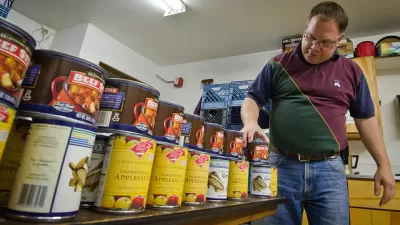Finally, some very, very good news: The U.S. Census released data that shows broad, big gains in household incomes.

The U.S. Census released new income and poverty data this week from the Current Population Survey, making news on many mainstream and planning-related news sites.
Vox, for instance, put out a spate of articles. One by Timothy B. Lee focuses on the disparity in the data for rural areas compared to urban areas. Here, he summarizes the geographic split apparent in the data:
In short, this is proving to be a fundamentally urban economic recovery. Cities are gaining income faster than their suburbs, which in turn are doing better than rural areas. And while suburban households still earn more, on average, than urban households, city-dwellers are closing the gap.
Another Vox article, by Dylan Matthews, frames the data in terms of class. According to Matthews, "the combination of fast income growth at the bottom and slower growth at the top meant that income inequality fell meaningfully between 2014 and 2015. It’s not enough to reverse the huge upward trend in inequality from the 1970s to the present, but it’s progress…"
Writing for CityLab, Kriston Capps begins by proclaiming that the data represents "unambiguously good news." Capps seizes on the three indicators of well-being reported in the Current Population Survey:
In 2015, the official poverty rate fell 1.2 percent. The percentage of people without health insurance decreased as well, reaching an all-time low of 9.1 percent. And to complete the trifecta, real median household income increased by 5.2 percent. If these indicators were colors, they’d be red, white, and blue.
Capps, however, is willing to express caution, in the form of the still-expensive housing market and a reminder that even all this good news has a ways to go to overcome the negative effects of the Great Recession.
For an institutional take on the new data, Jason Furman, Sandra Black, and Matt Fielder summarize six key points from the report for a post on the WhiteHouse.gov blog.
FULL STORY: American cities are getting richer. Rural areas are getting left behind.

Alabama: Trump Terminates Settlements for Black Communities Harmed By Raw Sewage
Trump deemed the landmark civil rights agreement “illegal DEI and environmental justice policy.”

Study: Maui’s Plan to Convert Vacation Rentals to Long-Term Housing Could Cause Nearly $1 Billion Economic Loss
The plan would reduce visitor accommodation by 25% resulting in 1,900 jobs lost.

Planetizen Federal Action Tracker
A weekly monitor of how Trump’s orders and actions are impacting planners and planning in America.

Restoring Northern India’s Himalayan ‘Water Temples’
Thousands of centuries-old buildings protect the region’s natural springs and serve as community wells and gathering places.

Milwaukee to Double Bike Share Stations
Bublr Bikes, one of the nation’s most successful, will add 500 new e-bikes to its system.

DC Extends Application Window for Outdoor Dining Permits
District restaurants will have until the end of November to apply, but businesses with permits in rush hour parking lanes must end operations on July 31.
Urban Design for Planners 1: Software Tools
This six-course series explores essential urban design concepts using open source software and equips planners with the tools they need to participate fully in the urban design process.
Planning for Universal Design
Learn the tools for implementing Universal Design in planning regulations.
Caltrans
Smith Gee Studio
Institute for Housing and Urban Development Studies (IHS)
City of Grandview
Harvard GSD Executive Education
Toledo-Lucas County Plan Commissions
Salt Lake City
NYU Wagner Graduate School of Public Service





























